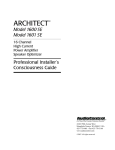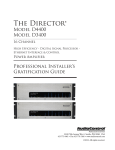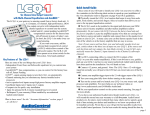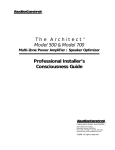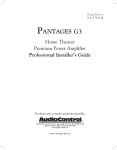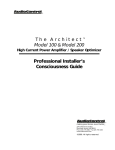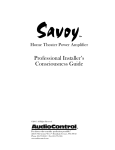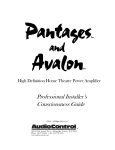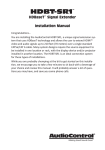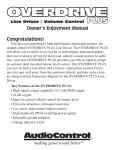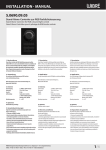Download Audio Control Architect 200 Installation guide
Transcript
™ ARCHITECT™ Model 1680 EQ • Model 1660 Model 1280 EQ • Model 1260 12 & 16 Channel Multi-Zone Amplifiers Professional Installer’s Guide ARCHITECT Model 1680 EQ – 16 Channel Amplifier with Speaker Equalizer ARCHITECT Model 1660 – 16 Channel Power Amplifier ARCHITECT Model 1280 EQ – 12 Channel Amplifier with Speaker Equalizer ARCHITECT Model 1260 – 12 Channel Power Amplifier ® Making Good Sound Great 22410 70th Avenue West • Seattle, WA 98043 USA 425-775-8461 • Fax 425-778-3166 • www.audiocontrol.com Project Information Dealer Name_________________________________________ Date Installed_________________________________________ Serial Number________________________________________ Ethernet MAC Address_________________________________ IP Address Dynamic / Static_____________________________ ® Table of Contents Table of Contents Architect Model 1280 EQ / 1260 / 1680 EQ / 1660 Product Highlights . . . . . . . . . . . . . . . . . . . . . . . . . . . . . . . . . . . . . . . . . 2 A Guided Tour Of the Architect Front Panel . . . . . . . . . . . . . . . . . . . . . . . . . . . . . . . . . . . . . . . . . . . . . . 3 Rear Panel . . . . . . . . . . . . . . . . . . . . . . . . . . . . . . . . . . . . . . . . . . . . . . . 4 Installation Guide Audio Hook-Up . . . . . . . . . . . . . . . . . . . . . . . . . . . . . . . . . . . . . . . . . . 6 System Diagrams . . . . . . . . . . . . . . . . . . . . . . . . . . . . . . . . . . . . 6 & 7 Remote Power Control . . . . . . . . . . . . . . . . . . . . . . . . . . . . . . . . . . . 8 Speaker Connections . . . . . . . . . . . . . . . . . . . . . . . . . . . . . . . . . . . . 9 Bridging the Architect . . . . . . . . . . . . . . . . . . . . . . . . . . . . . . . . . 10 Equalization Procedures . . . . . . . . . . . . . . . . . . . . . . . . . . . . . . . . . . 11 Equalization Controls . . . . . . . . . . . . . . . . . . . . . . . . . . . . . . . . . . . . . 13 Ethernet Connectivity Control Commands . . . . . . . . . . . . . . . . . . . . . . . . . . . . . . . . . . . . 16 Inquiry Commands . . . . . . . . . . . . . . . . . . . . . . . . . . . . . . . . . . . . 17 Troubleshooting . . . . . . . . . . . . . . . . . . . . . . . . . . . . . . . . . . . . . . . . . . 19 The Warranty . . . . . . . . . . . . . . . . . . . . . . . . . . . . . . . . . . . . . . . . . . . . . 22 Block Diagram . . . . . . . . . . . . . . . . . . . . . . . . . . . . . . . . . . . . . . . . . . . . 23 Specifications . . . . . . . . . . . . . . . . . . . . . . . . . . . . . . . . . . . . . . . . . . . . . 24 ARCHITECT ™ Model 1280 EQ • Model 1260 Model 1680 EQ • Model 1660 Installer’s Guide ® Introduction Introduction Congratulations! You are now installing a component which will dramatically improve the performance of any distributed audio system, especially those utilizing in-ceiling speakers. AudioControl Architect series amplifiers provide high levels of power, pristine sound quality, unique zone equalization controls, flexible input switching plus a number of installation friendly features that make them perfect products for performance oriented audio systems. The Architect™ 12 and 16 channel amplifiers are American-designed and built, “set and forget” components which will provide a lifetime of trouble-free service for your multi-room audio system. The Architect™ Series is designed and manufactured by AudioControl, the only electronics company in the world that specializes in amplifiers, equalizers, signal processors and audio analyzers. Our passion for high quality, meticulous attention to detail and pro sound heritage shows itself in the dozens of awards we have won for our designs, products and service. Now, as when we began, our greatest satisfaction is our reputation for sonic excellence and reliability among people just like you throughout the world. This manual is designed to help users get everything they can out of this Architect amplifier. So, even though you’re dying to see it in action, please take a few minutes to slog through our not-so-weighty prose and learn how to get the most from your Architect power amplifier. Anything as capable as this amplifier deserves all the explanation it can get. ARCHITECT ™ Model 1280 EQ • Model 1260 Model 1680 EQ • Model 1660 Installer’s Guide 1 Product Highlights The Architect Series Product Highlights Here is a list of features that are part of the Architect series from AudioControl and make these very unique products unlike any other amplifiers. • Superior Sound Quality; Pristine sonics happens first in all AudioControl designs and is not compromised by any other feature. You often get the feeling that sound quality is an after thought with products from other companies. • Unparalleled Energy Efficiency; Whether from the point of view of saving electricity or from the viewpoint of less heat in the rack, the Architect amplifiers have no equal. They are VERY energy efficient during operation and equally impressive with their efficiency during standby. During standby, these units draw less than 1 watt of power. More energy efficient AudioControl Amplifier • Speaker Equalization; The equalization circuit in the Architect is intended to provide a dramatic sound improvement for “small” speakers, such as those with 6-inch and 8-inch woofers. The Architect’s equalization centers were chosen to optimize in-wall and 2-way bookshelf speakers at critical frequencies where adjustment is most advantageous. The bandwidths (or ‘Q’ as engineering types call it) have been optimized for the difficulties that in-wall speakers present. This allows the Architect to improve the sound of these smaller speakers better than any other equalizer. Typical Amplifier • LightDrive Anti-clipping; With durability in mind, AudioControl’s LightDrive anti-clipping protection defends the system against clipping, distortion, damage and even teenage parties. • Self Resetting Protection Features; Protection features are extensive and include thermal, short circuit, clipping, ultrasonic and DC offset among others. If the fault is removed, the Architect amplifier resets. • Ethernet Control; (Available on Models 1281 EQ, 1261, 1681 EQ and 1661.) Via a browser or Telnet commands you can control and query almost all the functions. You can mute zones, change source inputs, display protection logs and get an email if something goes wrong. And this is only a partial list! • Pacific Northwest Heritage; Hard to believe, but we make this product in the USA. We are very proud of that fact. What is more important to you is the care we craft in at every step and the extensive knowledge we have in all aspects of the product. Plus, we back this up with a five year warranty. ® 2 A Guided Tour Of The Architect Model 1280 EQ and Model 1680 EQ Front Panel Stereo Speaker Equalization controls - This array of knobs provide up to 12dB boost or cut at 75Hz, 250Hz, 700Hz, 2500Hz and 12KHz. After initial adjustment the only time you would change the control settings are 1) if you connect different speakers into the system, 2) if (assuming the speakers aren’t built-in) you move them significantly, such as from a bookshelf to floor stands, or 3) if your room acoustics change through addition or rearrangement of furniture, wall or floor coverings, large hairy dogs, etc. Channel Status LED’s - These dual-color LED’s serve two purposes. First they illuminate Blue when the corresponding channel is active and operating properly. The second function of the status LED is to turn Red if something has caused a zone to go into protection. Architect Model 1680 EQ Architect Model 1280 EQ Protection LED - This LED has two faces. In normal operation it glows Blue when the remote power trigger is active and the Architect is in stand-by. If the Protection LED turns Red, then one of the internal protection circuits have engaged. The protection circuits automatically reset themselves when the problem causing the fault has been fixed. Should a major fault occur (lightning strike, act of God, etc.) see the “Troubleshooting“ section, page 19. Power LED - Nothing too tricky here...when you have the Master Power switch on the back panel turned on and the Architect is plugged into an active AC outlet, this little Blue light will shine forth. ARCHITECT ™ Model 1280 EQ • Model 1260 Model 1680 EQ • Model 1660 Installer’s Guide 3 Guided Tour Rear Panel Ethernet LAN Connection (Models 1681 EQ , 1660, 1281 EQ and 1261) – This enables control of the Architect via a standard 10BaseT computer network. The internal web server of the Architect also allows the technician to remotely monitor the status of the amplifier. See page 14 for more information. Bypass Switch – For diagnostics only. This button disables all the Ethernet control functions and forces all channels on. This is useful in case there is a problem with the home automation system and you really need some music. Signal Sense Defeat – The signal sensing circuitry activates a zone when a signal is present. To leave the Architect ready to play at all times, press this switch “In” (to Defeat). Bus Inputs 1 and 2 – These RCA inputs provide two distribution busses to provide a common signal to multiple zones. These inputs are used in conjunction with the Bus Input Switches on each amplifier zone. ® 4 Speaker Outputs – These terminal blocks are designed to make an installer smile. You can unplug the blocks and connect all of the speaker wires to them without balancing the Architect on your lap. This also makes it very simple to pre-wire a system. Local Trigger Inputs – This 1/8” mini-jack uses an external 12 volt trigger to switch the zone between the bus input and the local zone input. This is great for switching a room between the whole-house audio signal and a local source such as a television. The LED next to this jack indicates when the trigger is active. The trigger over rides signal sense. Mono – This button sums (Monos) the left and right inputs of the selected zone. This button is active when pressed in and does not affect any other zones. The Mono feature is also used when you are bridging a zone. Input Level Controls – This screwdriver adjustment controls the input sensitivity of the Architect amplifier. Guided Tour 13 15 13 11 12 14 Bus Select Switches – The switches below each zone’s local input jacks select the input source for that amplifier zone. If the switch is in the “Local” position, the zone receives audio signals from the local input. If the switch is in “Bus 1” or “Bus 2”, audio signals come from the appropriate “Bus” inputs. Whenever a Bus Input is selected, the zone input can be remotely triggered to the local input using the 12 volt Local Trigger input (see #6 on previous page). Local Inputs - These unbalanced RCA inputs connect to your preamplifier’s outputs. Any standard line level audio signal can be connected to these inputs. 11 AC Power Fuse – The Architect is designed with several layers of protection circuitry. The main AC power fuse is here just in case something really awful goes wrong. There are no internal fuses in this amp. 12 Master Power Switch – This switch shuts off the main AC power. Normally the only time you need to turn the master power switch off is if the system is going to be shut down for an extended period of time. 13 Remote Power Control – This three pin connector allows you to remotely turn on the Architect. You can either use a contact closure between the Trigger In and the +12V output or an external 12 volt trigger between the Control In and Ground terminals. The +12 volt output is not designed to power other pieces of equipment. 14 Ground Lift Switch – This switch selects the level of isolation between the audio signal ground and your AC earth ground. In normal operation this switch should be in the Ground position, but if you run into trouble with an AC ground hum, try the other two settings for the best operation. For your safety, the chassis is always connected to the earth ground regardless of the switch setting. 15 Remote Power control (1/8” jacks) - These mono 1/8” jacks are wired parallel to each other and work in conjunction with the 3-pin remote power connector. Either 1/8” input can receive a 12-volt trigger which will turn-on your Architect amplifier. This will then allow the unused jack to output 12 volts that can be used to turn-on a second amplifier. If your using the 3-pin connector to trigger the Architect, both of the 1/8” jacks can provide output trigger ARCHITECT ™ Model 1280 EQ • Model 1260 Model 1680 EQ • Model 1660 Installer’s Guide 5 Installation Guide InstallationGuide Audio Hook-up If you’re an installation veteran, this may seem repetitive, but some things can never be repeated too many times. 1. Turn off ALL components before making any connections. 2. When making connections, designate RED RCA plugs as RIGHT and WHITE, BLACK, or GREY plugs as LEFT. In fact, this is a good idea for ALL signal connections made in your audio system. The key is consistency. Stick with the same colorcoding and you’ll reduce possible problems. Using Bus Inputs to Create Larger Zones Dining Room Living Room Buss Inputs - Local Trigger Min 1 Ground Max 2 Local Buss 1 Buss 2 +12 VDC Out + Min Max 4 Local Buss 1 Buss 2 Min 6 7 Local Buss 1 Buss 2 Local Buss 1 Buss 2 Remote Power Control Mono AudioControl® 22410 70th Avenue West Mountlake Terrace, WA 98043 USA 425-775-8461 Fax 425-778-3166 www.audiocontrol.com ©2012 US Patent #5,708,577 Source Inputs Source Outputs Mono Mono Mono Input Selector - 11 + Mono 12 Local Trigger - 13 + AC Power 15 Max Min 11 - 14 - 16 + + Local Trigger Input Level 10 Local Buss 1 Buss 2 + Local Trigger Input Level Max Min Local Buss 1 Buss 2 Mono INSIDE. REFER TO QUALIFIED SERVICE PERSONNEL. Max 14 Local Buss 1 Buss 2 Mono CAUTION! AC Power Fuse FU Input Level 13 12 CAUTION: TO REDUCE THE RISK OF ELECTRICAL SHOCK, DO NOT REMOVE COVER. NO USER SERVICEABLE PARTS *Bridge Mode Connection Min 15 16 Mono Serial Number SE Max Local Buss 1 Buss 2 1200 watts 120V 240V Whole House Audio System Controller ® 6 Min 9 8 Trigger Input +12 VDC In/Out Local Trigger Max - 10 Input Level Min Max + 5. If you need to run the RCA audio cables more than 20 feet you should consider using an active balanced line driver for the signals. This will provide better noise rejection against nasty things like hum, spikes, local talk radio, etc. The AudioControl balanced line driver components (BLD-10, BLR-10 and BLX-10) are an excellent way to send audio over long distances with standard Cat-5 wiring. Check them out at audiocontrol.com. - + Input Level 5 - + 9 8 Local Trigger Local Trigger Input Level 3 - 6 * Float RC Ground +12 VDC In/Out 5 + Input Level Input Level + 7 + * Local Trigger Out - Active - 4 * Ground Isolation + * Bypass Signal Sense In - Defeat - 2 4. Use quality interconnect cables. We’re not going to get into the debate about whether $100/meter cables improve the sound, but we know from experience that really, REALLY cheap cables can cause a multitude Pool Area Patio Area Zone Zone of problems. They tend to break inside or corrode, causing a loss of signal or hum. They also have poor shielding. * 2 Link Data +3 1 * + * + 1 Family Room * Ethernet 3. Whenever possible, keep power cords away from signal cables to prevent induced hum. This is especially important if you bundle the cables to keep the installation neat looking. 10A 120 VAC Slo Blo T5AL 240 VAC Installation Guide Whole House System with Tuner Only Background Music ARCHITECT ™ Model 1280 EQ • Model 1260 Model 1680 EQ • Model 1660 Installer’s Guide 7 Installation Guide Remote Power Control The Architect has several means of power control: • Main AC Power switch - This is the master control and must be turned ON for the Architect to function. When the main power switch is on, the blue Power LED on the front panel lights up. Normally the only time that you would need to turn the AC power switch OFF is when the system is going to be unused for an extended period. Warning - Always connect the safety earth ground. If you have an AC hum problem, use the ground lift switch • Remote 12 volt Power Trigger - This removable 3-pin remote connector on the rear panel allows simple interfacing with external control systems. It accepts either a contact closure or external +12 volts DC. (see diagram) The two-color Protection LED on the front panel illuminates Blue to show that the remote power control is active. Installation Hint: If your installation doesn’t require this remote power turn-on, you must put a short piece of wire between the +12 V output and the Trigger In pins. • Mini Jack - Your Architect is equipped with two mono 1/8” jacks which are wired parallel to each other and work in conjunction with the 3-pin remote power connector. Either 1/8” input can receive a 12-volt trigger which will turn-on your Architect amplifier. Additionally the unused mini jack can then output 12 volts that can be used to turn-on secondary amplifier. If you are using the 3-pin connector to trigger the Architect, both of the 1/8” jacks can provide output trigger. • Ethernet Control - If you have the Architect Model 1281 EQ or 1681 EQ with the Ethernet control port you have remote control over the amplifiers power from almost anywhere in the world via the Internet. This is also very useful on a more local sense for integrating the amplifier with a home automation system via Ethernet. Do not use the 12v trigger if you are controlling the Architech via ethernet. Note: Do not use the 12 volt power trigger if you have an ethernet controlled unit. The power turn on is controlled by the ethernet. • Signal Sensing - Another level of amplifier control is the Signal-Sense circuitry. This provides individual channel muting control. When active, it senses that an audio signal is present on the RCA inputs then enables the power and unmutes that zone. The zone status LEDs on the front panel light up Blue when a signal is present. In some installations it may be desirable to defeat the signalsense control and leave all zones active regardless of the audio input. To defeat the signal-sense, press in the Signal-Sense Defeat button on the rear panel. ® 8 Installation Guide Speaker Connections The same rule applies to the speaker wires as the RCA connections. Establish a standard connection color code and stick with it. One conductor of the speaker wire is normally marked by a different color (silver versus copper) or there is a ribbing on one side. Typically this marked conductor is used for the positive (+) speaker leads. Of course the really good wire has Positive and Negative printed right onto the wire jacket. Speaker & Wiring Impedance Speaker impedance often is and should be straight forward. Speakers, like other resistors, wired in parallel “show” lower values than the individual components. In case you have forgotten, there is an example here for calculating speakers wired in parallel. Often the real world is more complicated than theory and for speakers this is the case. An eight ohm speaker is not eight ohms at all frequencies. Plus passive crossover networks add their own changing conditions. What you should be aware of and sensitive to are speakers that have significant dips from “nominal” values in portions of their frequency range and speakers that are rated at unusual impedances, for example 3.5 ohms. The Architect is tolerant of lower impedance loads, however, all good designs use some margin of error. Speaker connection wiring Calculating Impedance For three 8 ohm speakers wired in parallel (pluses connected to pluses) the impedance is 1/8 + 1/8 + 1/8 = 3/8 Then take the inverse or 8/3 = 2.66 ohms Your choice of speaker wire gauge and the length of the runs also affects the speaker impedance load presented to the amplifiers. As you can see in this table, even fairly short speakSpeaker Wire Resistance Wire Gauge versus Run Length er runs can have significant 25’ 50’ 100’ 250’ 500’ resistance if you use a smaller 24 GA 1.3 Ω 2.6 Ω 5.1 Ω 12.8 Ω 25.7 Ω wire gauge. This can be a benefit if you are paralleling lots 22 GA 0.8 Ω 1.6 Ω 3.24 Ω 8.1 Ω 16.0 Ω of speakers. The wire itself 20 GA 0.5 Ω 1.0 Ω 2.0 Ω 5.0 Ω 10.1 Ω acts as an impedance limiter, since the amplifier cannot 18 GA 0.3 Ω 0.6 Ω 1.28 Ω 3.2 Ω 6.4 Ω see a speaker load lower than the resistance of the wire. The 16 GA 0.2 Ω .4 Ω 0.8 Ω 2.0 Ω 4.0 Ω downside of this resistance 14 GA 0.1 Ω .25 Ω 0.5 Ω 1.26 Ω 2.5 Ω in the wire is that you waste some part of the total power 12 GA 0.08 Ω .16 Ω 0.32 Ω 0.8 Ω 1.6 Ω available to the speakers. ARCHITECT ™ Model 1280 EQ • Model 1260 Model 1680 EQ • Model 1660 Installer’s Guide 9 Installation Guide Bridging The Architect To increase the output power of the Architect amplifier you can join (bridge) two channels into a single channel of 250 watts. Accomplishing this is a simple matter. Just press the Mono button to send the same audio signal to both channels of the zone and then connect the speaker terminals as shown in the diagram below. Caution - Do not use a speaker rated at less than 8 ohms when bridging. In a bridged system, each channel of the bridged pair “sees” one half of the speaker load. This means that a bridged amp driving an 8 ohm speaker is actually operating into a 4 ohm load. Bridged connection speaker hookup Congratulations! You’re done with the audio hook up. Now for equalization… ® 10 Equalizing Procedures Equalization Procedures (Architect Model 1680 EQ & Architect Model 1280 EQ) Benefits of Equalization Rarely is the room layout and room decor designed to get the most out of the audio system. In fact, almost always the opposite is the case where the speaker positions and sizes are dictated by some factors which are actually contrary to good sound. This real world situation is where equalization can provide great benefits. Note: For the absolutely best results, The speaker optimizer controls on The Architecttm should be adjusted with a real time analyzer such as the AudioControl Industrial SA-3052. Speaker positions, furniture, and general room layouts may cause peaks in the frequency response. Fortunately these peaks can be tamed by judicious equalization. Also, it may be that the client has specific tastes, such as being the most interested in hearing voices such as ball game broadcasts, and you can tailor the sound to these tastes. At all times, though, the laws of physics are hard to violate. Equalization can not make terrible acoustics sound terrific only better. If the room has a tile floor and glass walls for example, the best case results will still be pretty bad by most measures. Further, while equalization can do wonders to help a less than perfect speaker, nothing will make a mediocre speaker sound fabulous. In other words, for best results, start with good speakers and reasonable room acoustics, if possible. SA-3052 Equalizing the System Before proceeding on equalizing the system, it is a good idea to make sure everything is connected and working properly. You know how to check connections and here are some reminders specific to the Architect, as well as the steps to equalize. 1. Turn on the system. The Power light on the front panel should be blue . 2. Play pink noise through the system into the zones you are going to adjust. If needed, there is a pink noise audio file at www.audiocontrol.com. Search for “pink noise”. 3. Now grab your trusty real time analyzer (RTA) and go into the zone you wish to adjust. 4. Place the microphone in the middle of the area of listening at the height of the typical listeners head. 5. In general, use the equalizer controls to lower peaks in the frequency response first. Peaks obscure the surrounding sounds and lowering the peaks will unleash overshadowed sounds. ARCHITECT ™ Model 1280 EQ • Model 1260 Model 1680 EQ • Model 1660 Installer’s Guide 11 Equalizing Procedures Audio Analysis It may take several series of adjustments since there is some interaction between each control. We have included some sample settings here and general descriptions of each control’s function further on page 13 or here. After initial adjustment the only time you would change the control settings are 1) if you connect different speakers into the system, 2) if (assuming the speakers aren’t built-in) you move them significantly, such as from a bookshelf to floor stands, or 3) if your room acoustics change through rearrangement of furniture, wall or floor coverings, large hairy dogs, etc. The following are examples of typical settings of the Architect™ Model 1280 EQ and1680 EQ Series Speaker Optimizer controls. Naturally, the results of adjustments will vary depending on the individual acoustic environment, the type of speakers, and the personal preferences of the listener. These recommendations are not concrete, they are simply good starting points. Example Settings ® 12 Equalization Controls Equalization Controls Here is a brief introduction to each of the Speaker Equalization control frequencies and what their affect on your music is. 75 Hz – Bass. This is at the bottom end of the frequencies which typical in-wall and small bookshelf speakers can achieve. Even though the Architect’s subsonic filter cuts frequencies under 40 Hz, boosting this band more than 6 dB can cause distortion. Adjust this band with care. A mild boost will enhance bass instruments such as bass guitar, kick drum, floor toms, timpani and double bass violas. 250 Hz and 700 Hz – High and low midrange. These controls directly affect the sound of instruments and vocals. These bands also determine the speaker’s presence (whether the music sounds far away or close in). Small speakers often produce too much midrange, so these controls are candidates for being turned down slightly during your initial experimentation. Definitely consider reducing 700 Hz if you are only using your extension speakers for background music. 2500 Hz – Treble. Female vocals and the “edge” of instruments such as guitars, snare drums, saxes, violins, etc. are found in this range. If accentuated too much (by boosting this control) sounds in the 2500 Hz range can seem harsh and fatiguing to the ear due to excessive output by the speaker or because of live, reflective room acoustics. 12 KHz – High treble. The fine detail, texture and sheen of music is found here. The breathiness of vocals, the sheen of cymbals, the high overtones of piano and strings. Actually, there’s audible music information up to 20,000 Hz on some CD’s and most adult’s hearing is still pretty good at 15,000 Hz. But we’ve chosen 12,000 Hz because it provides more useful control to compensate for room acoustics and common small-speaker deficiencies. ARCHITECT ™ Model 1280 EQ • Model 1260 Model 1680 EQ • Model 1660 Installer’s Guide 13 Ethernet Connectivity Ethernet Connectivity & Control (Architect Model 1681 EQ & Architect Model 1281 EQ) To further enhance the flexibility of the Architect amplifier, the Model 1281 EQ and Model 1681 EQ include a built-in web server. The server connects to the outside world using a 10 BaseT Ethernet LAN port and the TCP/IP network protocol. This network connection serves two purposes: With it’s built-in web server, you can access the Architect with any standard web browser to check on the amplifiers status and do some simple controls. This interface is also used to configure the network interface of the Architect. The second protocol on the network connection is a Telnet server. This is primarily used for integration with whole-house audio control systems. Now let’s see how to use this interface. To initially setup the Architect amplifier and configure the network interface you will need: Basic Network Setup • A computer with a 10BaseT Ethernet network adapter Important Note: If you have several Architects in your system. Only connect one at a time to the network until you have changed their IP addresses. From the factory the default IP address is 192.168.0.249. On a TCP/ IP network, each device MUST have a unique address. ernet cable • If you have an ethernet hub - A standard Eth- • Also you will need to change your computer IP address to a static address at 192.168.0.x. Anything except the default IP address of 192.168.0.249. Or • If you don’t have a hub – A Crossover Ethernet cable Once you have changed the computer’s address, connect the computer and the Architect together through the network, open your web browser software (Explorer, Firefox, Chrome or Safari) and enter the following address into your browser: Default IP address – http://192.168.0.249 You should now see the Main Operation web page of the Architect. From this page you have control to turn the Architect on, off and to mute or unmute each zone. Go ahead, give it a try: Turn on the amplifier and mute a channel or two. Now watch the front panel of the amplifier change. This screen is useful for general system diagnostics when you want to check out the amplifier operation. ® 14 Ethernet Connectivity To remotely access the web server of the Architect from an area outside of the local network you will need a full time connection to the Internet (Cable, T1), a router/firewall, and more than basic knowledge of TCP/IP network setup. Check with a professional. The simplest means of making the web server of the Architect accessible to the Internet is by using the Port Forwarding feature found in most Ethernet Routers and Firewalls. The Configuration page - Scroll to the top of the Main User page and click the Configuration button. This screen is where you get to setup some options for the network operation. Dynamic versus Static IP Address – This is pretty basic; a Dynamic IP address changes every time you log onto the network, a Static IP address always stays the same. A good example of a dynamic IP address is your standard Internet access. Your computer gets a different IP address assigned to it every time you connect. A network installation using Dynamic IP address requires a dedicated device known as a DHCP (Dynamic Host Control Protocol) server to assign the IP addresses from a pool of available addresses as each network device logs on. For an automation system we really recommend using a Static IP address setup. This makes it simple to always know what address to find a particular device, such as the Architect amplifier. Important Note: Make a note in the front of this manual, or better yet, on a sticker on the back of your Architect amplifier when you change the Static IP address setting. You will need to know that address to access the unit. If you forget the address, you can perform a system scan or reset the address to the factory default 192.168.0.249. by turning off the AC Power Switch on the back of the amplifier, hold in the reset switch (the small hole between the LAN LEDs) with a paper clip and then turn the power switch back on while holding the reset switch in for 5 seconds. This restores all the factory default settings. ARCHITECT ™ Model 1280 EQ • Model 1260 Model 1680 EQ • Model 1660 Installer’s Guide 15 Ethernet Connectivity The commands are broken into two groups: Control and Inquiries. The Controls issue instructions to the Architect for power control and channel muting; the Inquires return the status of amplifier channels, AC line voltage, the amplifier temperature, and the failure data log. Control Commands P0 (zero not ‘O’) Main Power Off B0 Defeats signal sense P1 Main Power On B1 Signal sense Active M1 Mute channel 1-2 H0 No header and footer to inquiries M2 Mute channel 3-4 M3 Mute channel 5-6 M4 Mute channel 7-8 M5 Mute channel 9-10 M6 Mute channel 11-12 M7 Mute channel 13-14 M8 Mute channel 15-16 MA Mute all channels 16 SIP Set IP address for notification messages. Address followed by colon and port number AP0 Automatic protect notification off AP1 Automatic protect notification on AC0 Automatic change notification off Automatic change notification on Clear all logs U1 Unmute channel 1-2 U2 Unmute channel 3-4 U3 Unmute channel 5-6 U4 Unmute channel 7-8 AC1 U5 Unmute channel 9-10 CL U6 Unmute channel 11-12 U7 Unmute channel 13-14 ® H1 Included header and footer U8 Unmute channel 15-16 UA Unmute all channels Ethernet Connectivity Inquiry Commands M? S? T? Binary string showing D? all zones mute status B? 0 = Mute 1 = Active (unmuted) H? (i.e. ‘001000’ – zone 3 is unmuted) Model ID three digit number Signal sense 0=Defeated, 1=Active Protection status (zone 1-8 and Amp) 1=Normal/Active 0=Mute/Standby 2=Protect 3=Short circuit Header/Footer Status 0=None, 1=Include See next page for header formats Temperature (zone 1-8) 0=Cool, 1=Normal 2=Warm 3=Thermal protection 4=Channel muted IP? IP address and port set for notifications. Active telnet session not required for notifications. AP? Automatic protect notification 0=off, 1=on AC? Automatic change notification 0=off, 1=on PB? Physical bypass 1= bypass switch engaged 0=not engaged P? Main power status – 0=off, 1=on V? AC Line voltage – 0 = Low (less than 105 VAC) 1 = Normal 2 = High (more than 125 VAC) L? Protection data log (comma delimited text) See next page for log formats ARCHITECT ™ Model 1280 EQ • Model 1260 Model 1680 EQ • Model 1660 Installer’s Guide 17 Ethernet Connectivity Header Format The response to inquiry commands may include both a header and footer for more precise identification if desired. The format of that header is as follows: IFBXXXXXXXXAC where I = the inquiry command, FB stands for feedback, X is the zone status, and AC is the footer identifying the response as from an AudioControl product. For example, the response MFB00100000AC is the response to a zone mute inquiry (M?) and shows all zones muted (“0”) except zone 3 (“1” being active or unmuted). Logging Format In response to a logging inquiry (L?), the Architect will respond with the most recent twenty events. The format of the logged response is: EECCYYYYMMDDHHMMSS where E= event code, C=zone, Y= year, M= month, D= day, H= hour, M= minute and S=second. Event code include: 00= DC offset/global protection 01= short circuit 02= over temperate For the zone code: 00 channel pair 1-2 01 channel pair 3-4 02 channel pair 5-6 03 channel pair 7-8 04 channel pair 9-10 05 channel pair 11-12 06 channel pair 13-14 07 channel pair 15-16 99 all zones, i.e. global protection ® 18 Troubleshooting Troubleshooting the Architect Many problems can be eliminated by re-checking the wiring and settings of the Architect amplifier. If a problem cannot be solved using the guide below, please call the AudioControl factory for further assistance or email us at [email protected] 1. No Sound a.Verify the Power LED is Blue. b.Verify Protection LED is Blue. c.Verify Channel Status LED is Blue. d.Verify Source unit is operating. e.Check the Speaker Connector plug on the rear panel f. Check the AC Power Fuse on the rear panel. 2. Protection LED is Blue, but none of the Channel Status LEDs are on: a.Defeat the Signal-Sense circuit using the switch on the rear panel. All of the Channel Status LEDs should turn on. If they do not, call the AudioControl factory. b.Verify Source unit is operating. c.Adjust the preamp volume higher. d.Adjust the Input Sensitivity control clockwise. 3. Channel Status LED is Red: a.Check speaker leads for a short. Swap speaker connectors on rear to see if the problem moves with the wires. b.If the Architect is excessively hot, turn down the volume and allow it to cool off. The Status LED should turn back to Blue after a short while. Verify that any ventilation holes have not become blocked. c.The speaker impedance may be too low. Use an ohmeter to measure the impedance on the speaker wires. ARCHITECT ™ Model 1280 EQ • Model 1260 Model 1680 EQ • Model 1660 Installer’s Guide 19 Troubleshooting 4. Speaker channels are cutting in and out: a.If using volume controls, check that they can handle the power output. b.When bridging, the amplifier “sees” one-half the stated speaker impedance rating. Make sure the impedance is high enough. (See page 9.) c. There may be a short in the wires. Suspect a short if the problem happens only at the highest volumes. 5. Protection LED is Red: a.Disconnect power from the unit for 3 to 4 minutes and reconnect to power. b.Something rather serious has happened inside the Architect. Call the AudioControl factory. 6. Speaker Buzzing or Cracking at high volume: • Reduce the equalizer boost at 75Hz. 7. There is no audio input signal, but the Channel Status LED is still Blue: a.Check the Signal-Sense defeat switch on the rear panel. If it is pressed in, the Channel Status LEDs will stay on as long as the Remote Power Control is enabled. b. The Channel Status LEDs stays on for 30-60 seconds (depending on music volume) after the audio signal has stopped to prevent prematurely turning off during quiet passages or song changes. 8. The unit is on but you cannot trigger it off (Model 1261/1661/1281/1681) • With the ethernet control, the unit will stay on if either the 12v trigger is on (or jumpered) or the ethernet control is set to on. 9. Is an in-wall volume control rated at 60 watts (continuous) adequate? • Just barely is the simple answer. Go for one with a higher rating if you want a reliable system. Though The Architect is rated at 65 watts, that is a conservative number and it can put out more power if only a few channels are driven. In contrast to the conservative rating of The Architect, the wall volume control may be rated using favorable assumptions. Also make sure the volume control power rating is continuous not peak. The continuous rating is about one-third of peak. ® 20 What to do if you need service What to do if you need service First, contact AudioControl, either by e-mail or phone. We’ll verify if there is anything wrong that you can correct yourself, or that it needs to be sent back to our factory for repair. Please include the following items with the returning unit: 1) A copy of your proof of purchase. No originals please. We cannot guarantee returning them to you. 2) A brief explanation of the trouble you are having with the Architect™. (You’d be surprised how many people forget this.) 3) A return street address. (No PO Boxes, please) 4) A daytime phone number in case our technician has a question about the problem you are having. You’re responsible for the freight charges to us, but we’ll pay the return freight back as long as the unit is under warranty. We match whatever shipping method you use to send it to us, so if you return the unit overnight freight, we send it back overnight. We recommend United Parcel Service (UPS) for most shipments. Repair service is available at: Attn: Service Department 22410 70th Avenue West Mountlake Terrace, WA 98043 USA Phone 425/775-8461 • FAX 425/778-3166 email: [email protected] ARCHITECT ™ Model 1280 EQ • Model 1260 Model 1680 EQ • Model 1660 Installer’s Guide 21 Warranty The Warranty Legalese Section People are scared of warranties. Lots of fine print. Months of waiting around. Well, fear no more. This warranty is designed to make you rave about AudioControl. It’s a warranty that looks out for you and your client, plus helps you resist the temptation to have your friend, who’s “good with electronics”, try to repair your AudioControl product. So go ahead, read this warranty, then register the information at www.audiocontrolregistration.com and include your comments. “Conditional” doesn’t mean anything ominous. The Federal Trade Commission tells all manufacturers to use the term to indicate that certain conditions have to be met before they’ll honor the warranty. If you meet all of these conditions, we will warrant all materials and workmanship on the Architect™ for five (5) years from the date you bought it, and we will fix or replace it, at our option, during that time. Here are the conditional conditions: 1. You need to register your purchases of the Architect™ with us by going to the AudioControl web site (www.audiocontrol.com), click on the “Home Theater” tab and then go to the warranty registration department and follow the directions. Optionally, go to www.audiocontrolregistration.com. 2. You must keep your sales receipt for proof of purchase showing when and from whom the unit was purchased. We’re not the only ones who require this, so it’s a good habit to get into with any major purchase. 3. The Architect™ must have originally been purchased from an authorized AudioControl dealer. You do not have to be the original owner, but you do need a copy of the original sales slip. 4. You cannot let anybody who isn’t: (A) the AudioControl factory; or (B) somebody authorized in writing by AudioControl to service the Archtiect. If anyone other than (A), or (B) messes with the Architect™, that voids your warranty. 5. The warranty is also void if the serial number is altered or removed, or if The Architect™ has been used improperly. Now that sounds like a big loophole, but here is all we mean by it: Unwarranted abuse is: (A) physical damage (don’t use the Architect™ to level your projection TV); (B) improper connections (120 volts into the RCA jacks can fry the poor thing); (C) sadistic things. This is the best product we know how to build, but if you strap it to the front bumper of your Range Rover, something might break. Assuming you conform to 1 through 5, and it really isn’t all that hard to do, we get the option of fixing your old unit or replacing it with a new one. This is the only warranty given by AudioControl. This warranty gives you specific legal rights, and you may also have rights that vary from state to state. Promises of how well the Architect™ will work are not implied by this warranty. Other than what we’ve said we’ll do in this warranty, we have no obligation, express or implied. We make no warranty of merchantability or fitness for any particular purpose. Also neither we nor anyone else who has been involved in the development or manufacture of the unit will have any liability of any incidental, consequential, special or punitive damages, including but not limited to any lost profits or damage to other parts of your system by hooking up to the unit (whether the claim is one for breach of warranty, negligence of other tort, or any other kind of claim). Some states do not allow limitations of consequential damages. Failure to register your product negates any service claims. The warranty included with the unit shall supersede this plain-text version if there is any inconsistency between the two. ® 22 Block Diagram Architect Amplifier Block Diagram ARCHITECT ™ Model 1280 EQ • Model 1260 Model 1680 EQ • Model 1660 Installer’s Guide 23 Specifications Architect Model Amplifiers Power . . . . . . . . . . . . . . . . . . . . . . . . . . . . . . . . . . . . . . . . . . All Channels Driven . . . . . . . . . . . . . . . . . . . . . . . . Single Zone Stereo Mode . . . . . . . . . . . . . . . . . . . . . . . . . . . . . . . . . . . . . . . . . . . . . . . . . . . . . . . . . . . . . . . . . . . . . . . . . . . . . . . . . 2 channels 8 ohm . . . . . . . . . . . . . . . . . . . . . . . . . . . . . . . . . . . . . . . . . . . . . . . . . 65 Watts . . . . . . . . . . . . . . . . . . . . . . . . . . . .65 Watts 4 ohm . . . . . . . . . . . . . . . . . . . . . . . . . . . . . . . . . . . . . . . . . . . . . . . . 100 Watts . . . . . . . . . . . . . . . . . . . . . . . . . . 130 Watts Bridged Mono 8 ohm . . . . . . . . . . . . . . . . . . . . . . . . . . . . . . . . . . . . . . . . . . . . . . . . 200 Watts . . . . . . . . . . . . . . . . . . . . . . . . . . 290 Watts Minimum Recommended Speaker Load . . . . . . . . . . . . . . . . . . . . . 4 ohms Damping Factor . . . . . . . . . . . . . . . . . . . . . . . . . . . . . . . . . . . . Greater than 200 Total Harmonic Distortion . . . . . . . . . . . . . . . . . 0.15% (Full Power, 20-20k) Signal to Noise . . . . . . . . . . . . . . . . . . . . . . . >100dB, A-wtd, Ref, Full Output Input Sensitivity . . . . . . . . . . . . . . . . . . . . . . . . . . . . . . . . . . Variable 0-1 Vrms Input Impedance . . . . . . . . . . . . . . . . . . . . . . . . . . . . . . . . . . . . . . 20 kilo ohms Crosstalk . . . . . . . . . . . . . . . . . . . . . . . . . . . . . . . . . . Greater than 80dB @ 1kHz Equalizer Center Frequencies . . . . . . . . . . . . . . 75, 250, 700, 2.5k, 12KHz Remote Power Trigger . . . . . . . . . . . . . . . +12 VDC or Dry Contact Closure AC Main Fuse Rating . . . . . . . . . . . . . . . . . . . . . . . . . . . . . . . . . 10 amp Slo-Blo AC Main Operational Voltage . . . . . . . . . . . . . . . . . . . . . . . . . . . . . . . . 95-130v Protection . . . . . . . clipping, short circuit, thermal, ultrasonic, DC offset . . . . . . . . . . . . . . . . . . . . . . . . Stable into reactive or mismatched loads Weight . . . . . . . . . . . . . . . . . . . . . . . . . . . . . . . . . . . . . . . . . . . 48 pounds (22 kg) Dimensions . . . . . . . . . . . . . . . . . . . . . . . . . . . . . . . . . . . 17” W x 16” D x 5.25” H Rack Mounting . . . . . . . . . . . . . . . . . . . . . . . . . . . . . . . . 3U high 19” Brackets Network Connection/Protcol . . . . . . . . . . . . . . . . 10BaseT Ethernet TCP/IP Communication Protocol . . . . . . . . . . . . . . . . . . . . . . . . . . . . . HTTP or Telnet Default Static IP Addressing . . . . . . . . . . . . . . . . . . . . . . . . . . . 192.168.0.249 InRush Current . . . . . . . . . . . . . . . . . . . . . . . . . . . . . . active limited, soft start Input power at standby . . . . . . . . . . . . . . . . . . . . . . . . . . . . . . . . . . . . . <1 Watt Current Consumption (all channels driven) Idle . . . . . . . . . . . . . . . . . . . . . . . . . . . . . . . . . . . . . . . . . . . . . . . . . . . . 24 Watts 1/8th Power (loud listening level) . . . . . . . . . . . . . . . . . . . . . . 240 Watts Full Power . . . . . . . . . . . . . . . . . . . . . . . . . . . . . . . . . . . . . . . . . . . 1600 Watts BTU/Hour Heat Dissipation (all channel driven) This manual was written, designed, Idle . . . . . . . . . . . . . . . . . . . . . . . . . . . . . . . . . . . . . . . . . . . . . . . . . . . . . . . . . . 85 printed, folded and stuffed into 1/8 Power (loud listening level) . . . . . . . . . . . . . . . . . . . . . . . . . . . . . . 330 the box in the U.S.A. Probably Full Power (worst case) . . . . . . . . . . . . . . . . . . . . . . . . . . . . . . . . . . . . . 1460 on a really grey and rainy day Country of Origin . . . . . . . . . . . . . . . . . . . . . . . . . . . . . . . . . . . . . . . . . . . . . . USA considering where we live. ® 24 Making Good Sound Great ® 22410 70th Avenue West Seattle, WA 98043 USA 425-775-8461 • Fax 425-778-3166 e-mail: [email protected] Visit us on the web at www.audiocontrol.com © AudioControl 2012, All Rights Reserved. P/N 913-117-0






























